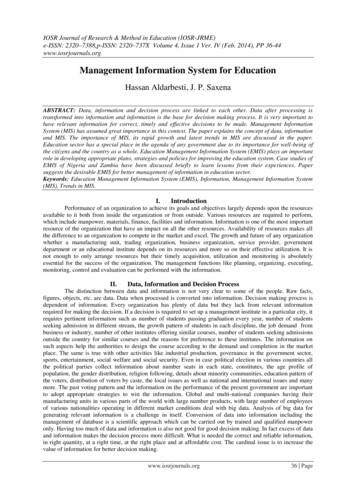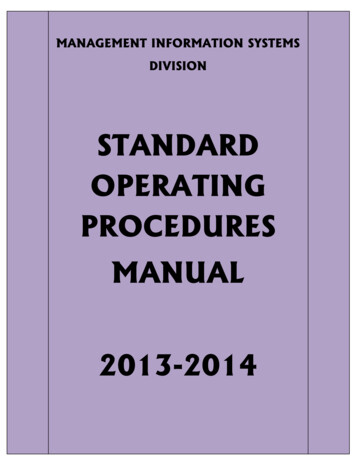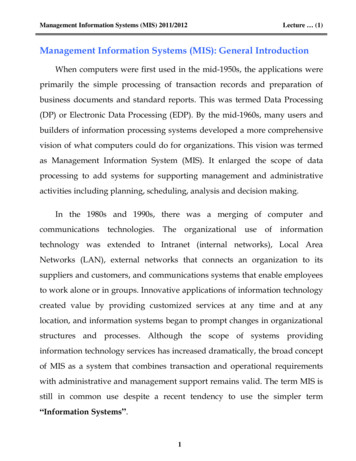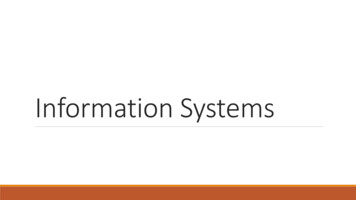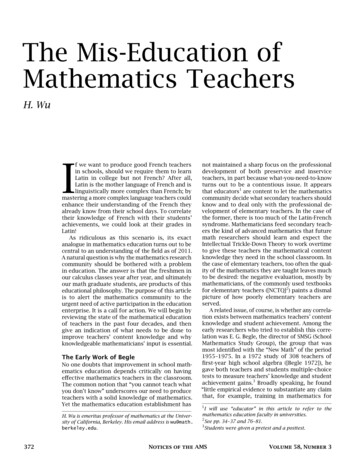
Transcription
The Mis-Education ofMathematics TeachersH. WuIf we want to produce good French teachersin schools, should we require them to learnLatin in college but not French? After all,Latin is the mother language of French and islinguistically more complex than French; bymastering a more complex language teachers couldenhance their understanding of the French theyalready know from their school days. To correlatetheir knowledge of French with their students’achievements, we could look at their grades inLatin!As ridiculous as this scenario is, its exactanalogue in mathematics education turns out to becentral to an understanding of the field as of 2011.A natural question is why the mathematics researchcommunity should be bothered with a problemin education. The answer is that the freshmen inour calculus classes year after year, and ultimatelyour math graduate students, are products of thiseducational philosophy. The purpose of this articleis to alert the mathematics community to theurgent need of active participation in the educationenterprise. It is a call for action. We will begin byreviewing the state of the mathematical educationof teachers in the past four decades, and thengive an indication of what needs to be done toimprove teachers’ content knowledge and whyknowledgeable mathematicians’ input is essential.The Early Work of BegleNo one doubts that improvement in school mathematics education depends critically on havingeffective mathematics teachers in the classroom.The common notion that “you cannot teach whatyou don’t know” underscores our need to produceteachers with a solid knowledge of mathematics.Yet the mathematics education establishment hasH. Wu is emeritus professor of mathematics at the University of California, Berkeley. His email address is wu@math.berkeley.edu.372not maintained a sharp focus on the professionaldevelopment of both preservice and inserviceteachers, in part because what-you-need-to-knowturns out to be a contentious issue. It appearsthat educators1 are content to let the mathematicscommunity decide what secondary teachers shouldknow and to deal only with the professional development of elementary teachers. In the case ofthe former, there is too much of the Latin-Frenchsyndrome. Mathematicians feed secondary teachers the kind of advanced mathematics that futuremath researchers should learn and expect theIntellectual Trickle-Down Theory to work overtimeto give these teachers the mathematical contentknowledge they need in the school classroom. Inthe case of elementary teachers, too often the quality of the mathematics they are taught leaves muchto be desired: the negative evaluation, mostly bymathematicians, of the commonly used textbooksfor elementary teachers ([NCTQ]2) paints a dismalpicture of how poorly elementary teachers areserved.A related issue, of course, is whether any correlation exists between mathematics teachers’ contentknowledge and student achievement. Among theearly researchers who tried to establish this correlation was E. G. Begle, the director of SMSG (SchoolMathematics Study Group), the group that wasmost identified with the “New Math” of the period1955–1975. In a 1972 study of 308 teachers offirst-year high school algebra ([Begle 1972]), hegave both teachers and students multiple-choicetests to measure teachers’ knowledge and studentachievement gains.3 Broadly speaking, he found“little empirical evidence to substantiate any claimthat, for example, training in mathematics for1I will use “educator” in this article to refer to themathematics education faculty in universities.2See pp. 34–37 and 76–81.3Students were given a pretest and a posttest.Notices of the AMSVolume 58, Number 3
mathematics teachers will have payoff in increasedmathematics achievement for their students”. Subsequently, he surveyed the empirical literature inmathematics education research and again confirmed that the available evidence did not supportthe belief that “the more one knows about one’ssubject, the more effective one can be as a teacher”(p. 51, [Begle1979]).The 1972 work of Begle is best known for castingdoubt on the relevance of mathematical contentknowledge to the effectiveness of teaching, but aclose examination of this report is extremely instructive. Begle administered two tests to teachers,one on the algebra of the real number system andthe other on the level of the abstract algebra ofgroups, rings, and fields. Analysis of the resultsindicated to Begle that. . .teacher understanding of modern algebra (groups, rings, andfields) has no significant correlation with student achievement inalgebraic computation or in the understanding of ninth grade algebra. . .However, teacher understandingof the algebra of the real number system does have significantpositive correlation with studentachievement in the understandingof ninth grade algebra. (Page 8 oforiginal text in [Begle 1972].)From these findings, Begle arrived at the followingtwo remarkable recommendations:The nonsignificant relationship between the teacher modern algebrascores and student achievementwould suggest the recommendationthat courses not directly relevantto the courses they will teachnot be imposed on teachers. Thesmall, but positive, correlation between teacher understanding ofthe real number system and student achievement in ninth gradealgebra would lead to the recommendation that teachers should beprovided with a solid understanding of the courses they are expectedto teach. . . (ibid.).It is to be regretted that Begle did not followthrough with his own recommendations. Had thatbeen done, there would have been no need forthe present article to be written. Let us put thisstatement in context. Begle was dealing with highschool teachers who are traditionally required tocomplete the equivalent of a major in mathematics.However, the requirements for math majors aredesigned mainly to enable them to succeed asmathematics graduate students and, for this veryreason, are full of “courses not directly relevantMarch 2011to the courses [teachers] will teach” in the schoolclassroom. Implicitly, Begle recognized back in1972 a critical flaw in the preservice professionaldevelopment of high school teachers, namely,they are fed information that doesn’t directlyhelp them with their work. In other words, weteach Latin to French teachers and hope that theywill become proficient in teaching French. Begle’ssecond recommendation hinted at his awareness ofthe complementary fact, namely that high schoolteachers do need courses that provide them with asolid understanding of what they teach.Basic Criteria of Professional DevelopmentBegle’s work was carried on by others in theintervening years, notably by [Goldhaber-Brewer]and [Monk]. But the work that is most relevant tothe present article is that of Deborah Ball, whosome twenty years after Begle considered whatteachers need to know about the mathematicsof elementary school ([Ball]). Her survey of bothelementary and secondary teachers showed thateven teachers with a major in mathematics couldnot explain something as basic as the divisionof fractions (a basic topic in grades 5 and 6) ina way that is mathematically and pedagogicallyadequate. Her conclusion is that “the subject matterpreparation of teachers is rarely the focus of anyphase of teacher education” (p. 465, [Ball]).A few years later, as a result of my work withthe California Mathematics Project (cf. [Wu1999c]),I became alarmed by the deficiency of mathematics teachers’ content knowledge and argued ontheoretical grounds that improvement must besought in the way universities teach prospectivemathematics teachers ([Wu1999a], [Wu1999b]).4The conclusions I arrived at are entirely consistent with those of Begle and Ball, and a slightlysharpened version may be stated as follows. Tohelp teachers teach effectively, we must providethem with a body of mathematical knowledge thatsatisfies both of the following conditions:(A) It is relevant to teaching, i.e.,does not stray far from the materialthey teach in school.(B) It is consistent with the fundamental principles of mathematics.The rest of this article will amplify on these twostatements.Three ExamplesThe almost contradictory demands of these twoconsiderations on professional development isillustrated nowhere better than in the teachingof fractions in school mathematics. Although4I wish I could say I was aware of the work of Begle andBall at the time that those articles were written, but I can’t.Notices of the AMS373
fractions are sometimes taught as early as secondgrade nowadays, the most substantial instructionoccurs mainly in grades 5–7, and students’ difficultywith learning fractions in these grades is part ofAmerican folklore.5 We will henceforth concentrateon fractions in grades 5–7.Mathematicians who have a dim memory oftheir K–12 days may of course wonder whythe teachers of these grades must be providedwith a knowledge of fractions that is relevantto the school classroom. What is so hard aboutequivalence classes of ordered pairs of integers?Let us recall how fractions are taught in universitymathematics courses. As usual, let Z be the integers,and let S be the subset of ordered pairs of integersZ Z consisting of all the elements (x, y) so thaty 0. Introduce an equivalence relation in S bydefining (x, y) (z, w ) if xw yz. Denoting thexequivalence class of (x, y) in S by y , we call the setxof all such y the rational numbers Q. Identify Zwith the set of all elements of the form 1x , and wehave Z Q. Finally, we convert Q into a ring bydefining addition and multiplication in Q asxzxw zyx zxz , and· .ywywy wywOf course we routinely check the compatibility ofthese definitions with the equivalence relation. Thisis what we normally teach our math majors in twoto three lectures; it is without a doubt consistentwith the fundamental principles of mathematics.The question is: what could a teacher do with thisinformation in grades 5–7? Probably nothing.Let us analyze this definition a bit: it requiresan understanding of the partition of S into equivalence classes and the ability to consider eachequivalence class as one element. Acquiring suchan understanding is a major step in the educationof beginning math majors. In addition, understanding the identification of Z with { 1x : x Z}, or aswe say, the injective homomorphism of Z into Q,requires another level of sophistication.Surely very little of the preceding discussionis comprehensible to students of ages 10–12,but even more problematic are the definitions ofaddition and multiplication of rational numbers.For example, consider multiplication once additionxzxzhas been defined. The definition y · w ywmakes sense to us because we want to introduce aring structure in Q and this is the most obviousway to make it work. But can we explain to anaverage pre-teenager that rings are important andthat therefore this definition of multiplication isthe right definition? If so, what is wrong withxzx zdefining y w as y w in accordance withevery school student’s dream?5If in doubt, look up Peanuts and FoxTrot comic strips.374Because schools were in existence before the introduction of fractions in the 1930s as equivalenceclasses of ordered pairs of integers, and becausefractions have been taught in schools from thebeginning, it is a foregone conclusion that someversion of fractions has been taught to teachers fora long time. But this version of mathematics makesno pretense of teaching mathematics. At least inthis case, the relevance to the school classroom hasbeen achieved at an unconscionable cost, namelyat the expense of the fundamental principles ofmathematics.Mathematics depends on precise and literaldefinitions, but the way fractions are taught toelementary teachers has almost no definitions.The following is a typical example. A fraction ispresented as three things all at once: it is a partof a whole, it is a ratio, and it is a division. Thus3is 3 parts when the whole is divided into 44equal parts. Because it is not clear what a “whole”is, the education literature generally resorts tometaphors. Thus a prototypical “whole” is likea pizza. Now do we divide a pizza into 4 equalparts according to shape? Weight? Or is it area?The education literature doesn’t say. And how tomultiply or divide two pieces of pizza? (See [Hart].)As to a fraction being a ratio, 34 can representa “ratio situation”, as 3 boys for every 4 girls.What is the logical connection of boys and girlsto pizzas? The education literature is again silenton this point, except to make it clear that everyfifth grader had better acquire such a conceptualunderstanding of a fraction, namely that it canbe two things simultaneously. Finally, the fraction3is also “3 divided by 4”. Now there are many4things wrong with this statement, foremost beingthe fact that when students approach fractions,they are either in the process of learning aboutdivision of whole numbers or just coming out of it.In the latter situation, they understand m n (forwhole numbers m and n, n 0) to be a partitioninto equal groups or as a measurement only whenm is a multiple of n. If m is not a multiple of n,then students learn about division-with-remainder,in which case m n yields two numbers, namely,the quotient and the remainder. The concept of asingle number 3 4 is therefore entirely new toa student trying to learn fractions, and to define3in terms of 3 4 is thus a shocking travesty of4mathematics. What is true is that, when “part of awhole” is suitably defined and when m n is alsosuitably defined for arbitrary whole numbers mand n (n 0), it is a provable theorem that, indeed,m m n. Yet, there is no mention of this factnin the education literature, and such absence ofreasoning pervades almost all such presentationsof fractions.As a result of this kind of professional development, a typical elementary teacher asks herNotices of the AMSVolume 58, Number 3
students to believe that there is a mysteriousquantity called fraction that possesses three totallyunrelated properties and then also asks them tocompute with this mysterious quantity in equallymysterious ways. To add two fractions, take theirleast common denominator and then do some unusual things with the numerators to get the sum.6Of why, and of how, this concept of addition isrelated to the concept of adding whole numbers as“combining things”, there is no explanation at all.Recall that we are here discussing the mathematical education of elementary teachers. We haveto teach them mathematics so that, with properpedagogical modifications, they can teach it toprimary students, and so that, with essentially nomodification, they can teach it to students in theupper elementary grades. So how can a teacherteach the addition of fractions in grades 5–7? If aafraction b is defined to be a point on the numberacline, then the sum of two fractions b and d is,by definition, the total length of the two intervals[0, ab ] and [0, dc ] joined end-to-end—just as is thecase of the sum of two whole numbers. In this way,adding fractions is “combining things” again. Acad bcasimple reasoning then gives b d bd . See, forexample, pp. 46–49 of [Wu2002].Next, consider division. The rote teaching ofthe division of fractions is a good example ofthe total neglect of the fundamental principles ofmathematics, and it has inspired the jingle, “Oursis not to reason why, just invert and multiply.” Onerecent response to such rote teaching is to imitatedivision between whole numbers by teachingthe division of fractions as repeated subtraction.Unfortunately, the concept of division in a fieldcannot be equated with the division algorithm ina Euclidean domain, and the reaction against adefective mathematical practice has resulted in theintroduction of another defective mathematicalpractice. Such a turn of events seems to be typicalof the state of school mathematics education inrecent times.In any intellectual endeavor, a crisis of this naturenaturally calls for research and the infusion of newideas for a resolution. What is at present missingis the kind of education research that addressesstudents’ cognitive development without sacrificingprecise definitions, reasoning, and mathematicalcoherence in the teaching of fractions (see pp. 33–38 in [Wu2008a] for a brief discussion of theresearch literature).To improve on fraction instruction in schools, wefirst need to produce school textbooks that presenta mathematically coherent way of approachingthe subject, one that proceeds by reason ratherthan by decree. Several experiments along this6This is tantamount to saying that addition cannot be defined in the quotient field of a domain unless the latter issomething like a UFD.March 2011line were tried in the past two decades, but let usjust say that, from the present perspective, theywere not successes. An easier task would be toproduce professional development materials forelementary teachers that are sufficiently elementaryfor students in grades 5–7. This would requirea presentation of the mathematics of fractionsdifferent from the mathematically incoherent onedescribed above. One way that has been thoroughlyworked out is to define a fraction, in an explicitmanner, as a point on the number line ([Jensen]and [Wu2002]). It does not matter whether teachersare taught this or possibly other approaches tofractions for school students; the important thingis that teachers are taught some version that isvalid in the sense of conditions (A) and (B) aboveso that they can teach it in the school classroom. Itis simply not realistic to expect teachers to developby themselves the kind of knowledge that satisfies(A) and (B).Two additional comments on fractions willfurther illuminate why we need to specificallyaddress the special knowledge for teaching. Atpresent, a major stumbling block in the learningpath of school students is the fact that fractions aretaught as different numbers from whole numbers.For example, it is believed that “Children mustadopt new rules for fractions that often conflictwith well-established ideas about whole numbers”([Bezuk-Cramer], p. 156). The rules here presumablyrefer to the rules of arithmetic; if so, we can saycategorically that there is a complete parallelbetween these two sets of rules for whole numbersand fractions; the similarity in question is a mainpoint of emphasis in [Wu2002]. If mathematicianswho take for granted that Z is a subring of Q aresurprised by this misconception about fractionsand whole numbers, they would do well to askat which point of teachers’ education in K–16 (or,for that matter, a teacher’s education, period) theywould get an explicit understanding of this basicalgebraic fact. The unfortunate answer is probably“nowhere”, because until the last two years incollege, mathematics courses are traditionallymore about techniques than ideas, and even forthose junior- and senior-level courses, our usualmode of instruction often allows the ideas tobe overwhelmed by procedures and formalism(cf. [Wu1999a]). It should be an achievable goal forall teachers to acquire an understanding of thestructural similarity between Z and Q so that theycan teach fractions by emphasizing the similarityrather than the difference between whole numbersand fractions.A second comment is that school mathematicsis built on Q (the rationals) and not on R (the reals).Q is everything in K–12, while R appears only as aNotices of the AMS375
pale shadow.7 It is this fact that accounts for theneed to teach fractions well. We hope all teachersare aware of the dominance of Q in their day-to-daywork,8 but few are, for the simple reason that wehave never brought it to their attention.In terms of the nitty-gritty of classroom instruction, real numbers are handled in K–12 by whatis called the Fundamental Assumption of SchoolMathematics (FASM; see p. 101 of [Wu2002] andp. 62 of [Wu2008b]). It states that any formulaor weak inequality that is valid for all rationalnumbers is also valid for all real numbers.9 Forexample, in the seventh grade, let us say, theformula for the addition of fractions,acad bc ,bdbdwhere a, b, c, d are whole numbers, can be (andshould be) proved to be valid when a, b, c, d arerational numbers. By FASM, the formula is alsovalid for all real numbers a, b, c, d. Thus highschool students can write, without blinking an eye,that 123 2 2 ,232 3 even if they know nothing about what 1/ 2 or2 3 means. If this seems a little cut-and-driedand irrelevant, consider the useful identity112for all real numbers x. 1 x1 x1 x2If x is rational, this identity is easily verified(see preceding addition formula). But the identityimplies also112 .1 π1 π1 π2Without FASM, there is no way to confirm thisequality in K–12, so its validity is entirely an articleof faith in school mathematics.As a final example, let a be any positive numberp 1. Then for all rational numbers mand q , thenfollowing law of exponents for rational exponentscan be verified (even if the proof is tedious):am/n · ap/q am/n p/q .Now, FASM implies that we may assume that thefollowing identity holds for all real numbers s andt:as · at as t .Of course, school mathematics cannot make senseof any of the numbers as , at , and as t when s and tare irrational, much less explain why this equalityis valid. Nevertheless, this equality is of more7This fundamental fact seems to have escaped Begle, asevidenced by his tests for teachers ([Begle1972]).8Better yet, one hopes that all state and national standardsreflect an awareness of this fact as well, but that is just aforlorn hope.9A trivial consequence of continuity and the density of Qin R.376than purely academic interest because it is neededto describe a basic property of the exponentialfunction ax : R (0, ).The preceding discussion brings out the factthat any discussion in high school mathematics isbound to be full of holes, and FASM is needed to fillin those holes. We would like to believe that FASMis a basic part of the professional developmentof mathematics teachers. Yet, to our knowledge,FASM has never been part of such professionaldevelopment, with the result that schoolteachersare forced to fake their way through the awkwardtransition from fractions to real numbers in middleschool. It is difficult to believe that, when teachersmake a habit of blurring the distinction betweenwhat is known and what is not, their teachingcan be wholly beneficial to the students. There isdefinitely room for improvement in our educationof mathematics teachers.Another illustration of the difference betweenthe teaching of mathematics to the average university student and to prospective teachers is theconcept of constant speed. Consider the followingstaple problem in fifth or sixth grade:If Ina can walk 3 25 miles in 90minutes, how long would it takeher to walk half a mile?A common solution is to set up a proportion:Suppose it takes Ina x minutes to walk half amile; then proportional reasoning shows that “thedistances are to each other as the times”. Therefore3 52 is to 21 as 90 is to x. So23512 90.xBy the cross-multiplication algorithm:142· 90, so that x 13minutes.3 ·x 5217The answer is undoubtedly correct, but what isthe reasoning behind the setting up of a proportion?This rote procedure cannot be explained becausethe assumption that makes possible the explanationhas been suppressed, the fact that Ina walks ata constant speed. As we know, if there is noassumption, then there is no deduction either. Ittherefore comes to pass that problem solving inthis case is reduced to the rote procedure of settingup a proportion.How did school mathematics get to the pointthat “constant speed” is not even mentionedor, if mentioned, is not explained in the schoolclassroom? It comes back to the issue of how weeducate our teachers. The only time universitymathematics deals with constant speed is incalculus, where a motion along a line f (t) describingthe distance from a fixed point as a function oftime t is said to have constant speed if its derivativef 0 (t) is a constant. There are teachers who don’ttake calculus, of course, but even those who doNotices of the AMSVolume 58, Number 3
will see constant speed as a calculus concept andnothing else. Because we do not see fit to helpprospective teachers relate university mathematicsto school mathematics, such a misconceptionabout constant speed will remain with them. Inthe school classroom, they realize that there isno place for the derivative and therefore concludethat it is impossible to discuss constant speed.Once this realization sets in, they fall back on whatthey learned as students in K–12, which is not totalk about constant speed at all. So the traditioncontinues, not just in the classroom instructionbut also in textbooks.Having taken calculus is usually considered abadge of honor among middle and elementaryschool teachers, and some professional development programs go out of their way to includecalculus exactly for this reason. The example ofconstant speed is but one of the innumerablereasons why having taken a standard calculuscourse does not ensure a teacher’s effectiveness inthe school classroom.10Professional development of teachers ideallyshould include the instruction that in the schoolcurriculum the concept of speed is too subtle tobe made precise, but that one should use insteadthe concept of average speed in a time interval[t, t 0 ], which is the quotient(the distance traveled from time t to time t 0 ).(t 0 t)A motion is said to have constant speed K if, forevery time interval [t, t 0 ], the average speed isalways equal to K, i.e.,(the distance traveled from time t to time t 0 ) K.(t 0 t)Once this concept is introduced, the setting upof a proportion in the preceding example canbe explained provided Ina is assumed to walk at aconstant speed. For then her average speeds in thetwo time intervals [0, 90] and [0, x] are the same,and therefore13 25 2 ,90xand this equality is equivalent to the proportionabove.Of course school students would find it difficultto grasp the idea that the average speed in everytime interval is a fixed number, and educationresearchers should consider how to lighten theattendant cognitive load. But that is a differentstory. Our concern here is whether prospectiveteachers are taught what they need to knowin order to carry out their duties, and onceagain we see the gulf that separates what ismathematically correct in a university settingfrom what is pedagogically feasible in a school10Calculus is by definition, as well as by design, atechnique-oriented subject.March 2011classroom. What is needed to bridge this gulf isthe concept of customizing abstract mathematicsfor use in the school classroom. This is the essenceof mathematics education (see [Wu2006] for a fulldiscussion). In this case, it is a matter of takingapart the concept of the constancy of the derivativeof a function and reconstructing it so that it makessense to school students.As a final example to illustrate the chasmbetween what we teach teachers and what theyneed to know, consider the fundamental conceptsof congruence and similarity in geometry. The gapsin our teachers’ knowledge of these two conceptsare reflected in the existing school geometrycurricula. For example:(i) In middle school, two figures (notnecessarily polygons) are definedto be congruent if they have thesame size and same shape and tobe similar if they have the sameshape but not necessarily the samesize. In high school, congruenceand similarity are defined in termsof angles and sides, but only forpolygons. There is no attempt toreconcile the more precise definitions in high school with the generalones in middle school.(ii) In middle school, the purposeof learning about congruence isto perceive the inherent symmetries in nature as well as in artisticdesigns such as Escher’s prints, tessellations, and mosaic art. Likewise,the purpose of learning about similarity is to engage in fun activitiesabout enlarging pictures. In highschool, students prove theoremsabout congruent and similar triangles in a geometry course butotherwise never again encounterthese concepts in another coursein school mathematics.(iii) Because similarity is more general than congruence and becausetwo figures are more likely tobe similar than congruent, somecurricula ask teachers to teach similarity before congruence in middleschool.11As a result of the neglect by universities, ourteachers’ conception of congruence and similarityis largely as fragmented and incoherent as thepractices described in (i)–(iii) above. Not every11It is possible to define similarity as a bijection of theplane that changes distance of any two points by a fixedscale factor k and to define a congruence as the case ofk 1. This approach is, however, basically impossible tobring off in a school classroom.Notices of the AMS377
school geometry curriculum is guilty of all three,but most are guilty of the first two. So long asuniversity mathematics courses do not addressissues arising from school mathematics, teacherswill not be sufficiently well informed to rejectsuch mathematical illiteracy, and publishers willcontinue to get away with the promotion of thiskind of illiteracy. We must create a universitymathematics curriculum for prospective teachersto help them look back at such school concerns asthe meaning of congruence and similarity and whythese concepts are important in mathematics. Bycontrast, preservice teachers are given at least someaccess to such topics as the curvature of curves,Gaussian curvature of surfaces, finite geometry,projective geometry, non-Euclidean geometries,and the foundations of geometry. They are not,however, taught plane Euclidean geometry. Thislast is exactly what teachers need because it isusually taught poorly in schools. They desperatelyneed solid information about school geometry inorder to better teach their own geometry classes.Thus we see in this case the same scenariothat we saw with fractions play
5If in doubt, look up Peanuts and FoxTrot comic strips. Because schools were in existence before the in-troduction of fractions in the 1930s as equivalence classes of ordered pairs of integers, and because fractions have been taught in schools from the beginning, it is a foregone conclus
